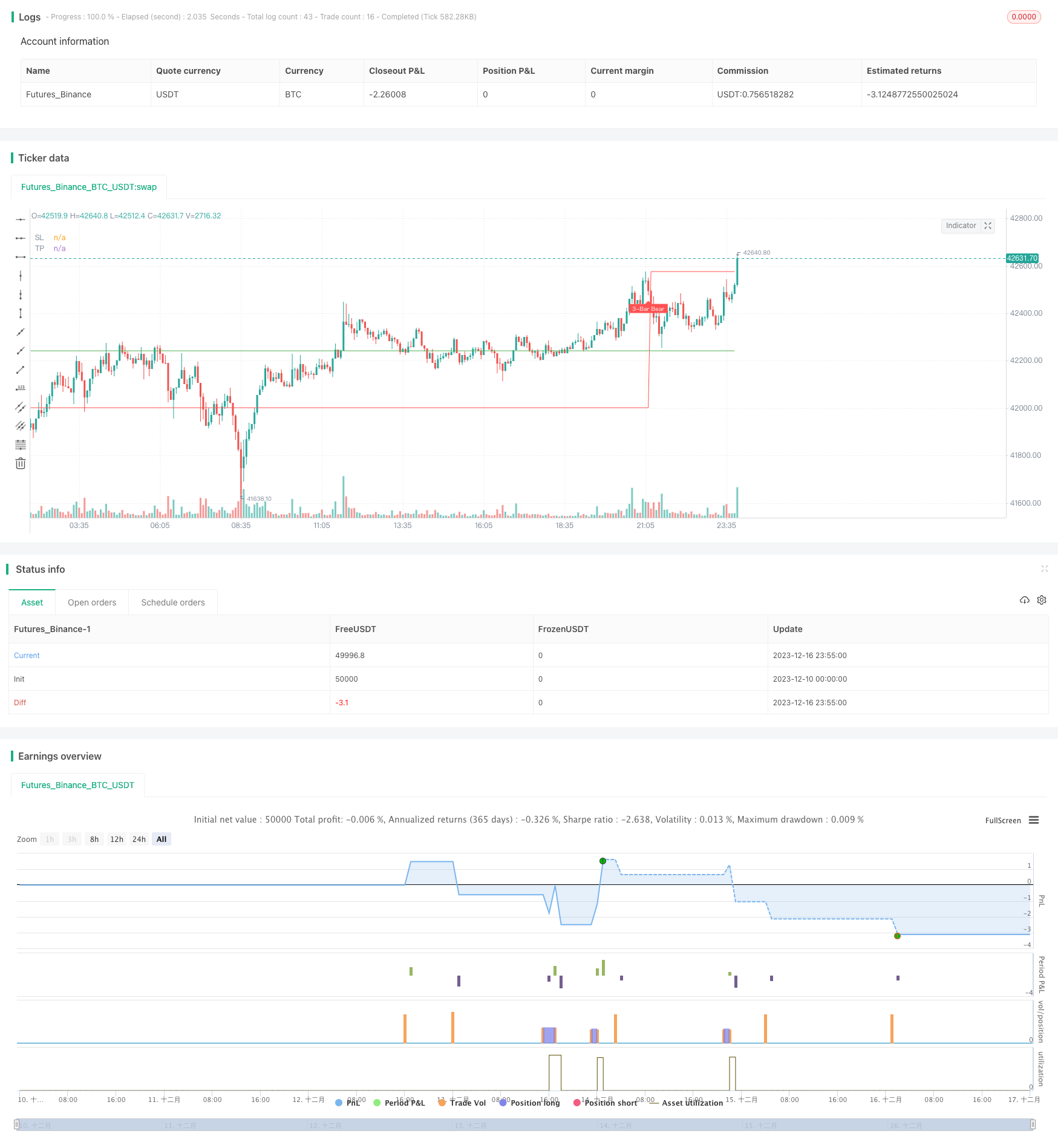
概述
三四K线突破反转策略通过识别K线上涨势头较大的三根K线或四根K线,在其后几根较小幅度的K线形成支撑或压力后,在反转K线发生时进行逆势交易,属于逆势交易策略。
策略原理
该策略的核心识别逻辑主要有以下几个部分:
识别增大幅度的K线(Gap Bar):突破1.5倍平均ATR,实体部分大于0.65。该K线被认为具有较强的涨跌势头。
识别缩量整理的K线(Collecting Bar):跟随Gap Bar后面1-2根小幅度波动的K线,高点或低点接近Gap Bar。这些K线代表着趋势的减缓和盘整,形成了支撑或压力。
识别反转信号K线:在盘整K线后,如果出现一根实体突破前几根K线的高点或低点的K线,就可以认为是一个反转信号,根据实体方向判断做多还是做空,在该K线开仓。
止损和止盈:止损设置在Gap K线低点之下或高点之上;止盈基于止损点乘以配置的盈亏比例。
优势分析
该策略具有以下几个主要优势:
利用K线本身的特征判断趋势和反转点,不依赖任何指标,实现了“指标自带”。
Gap Bar和Collecting Bar的筛选条件严格,可以有效识别真正的趋势和盘整。
反转信号判断以实体为准,减少了假信号的概率。
只需3-4根K线组合就可以完成一次交易,时间周期短,频次高。
止盈止损设置明确,回撤和盈亏比容易控制。
风险分析
该策略也存在以下一些风险:
依赖参数设置的质量,如果参数设置过于宽松,会增加假信号和赔钱交易的机会。
容易受到高频假突破的干扰,无法有效过滤全部假信号。
存在被套住的风险,如果反转不足时易形成调整,从而无法止损。
止损范围比较大,个别被套机会可能造成较大亏损。
为降低这些风险,可以从以下几个方面进行优化:
优化参数,使Gap Bar和Collecting Bar识别更为准确。
增加过滤器,在反转K线再次确认后开仓。
优化止损算法,使止损更贴近价格,亏损更可控。
优化方向
该策略还有以下几个主要的优化方向:
增加复合过滤器,避免假突破干扰。例如增加成交量指标,只在成交量放大的情况下考虑交易信号。
结合均线指标,只在价格突破重要均线(如20日线,60日线)时考虑交易信号。
多时间框架验证,只有多个周期同时给出信号时才开仓。
优化止盈条件,根据市场波动程度和风险偏好动态调整盈亏比。
结合市场多空状态判断系统,只在趋势性market的环境下使用该策略。
这些优化可以进一步提高策略的稳定性和盈利概率。
总结
三四K线突破反转策略通过识别高质量的趋势潜力段和反转信号进行交易。操作周期短,频次高,有望获取丰厚的超额收益。同时也存在一定的风险,需要继续优化以降低风险提高稳定性。总的来说,该策略有效地利用了行情轮廓自身的特征判断趋势和反转点,值得进一步研究和应用。
/*backtest
start: 2023-12-10 00:00:00
end: 2023-12-17 00:00:00
period: 5m
basePeriod: 1m
exchanges: [{"eid":"Futures_Binance","currency":"BTC_USDT"}]
*/
//@version=4
strategy(title="Three (3)-Bar and Four (4)-Bar Plays Strategy", shorttitle="Three (3)-Bar and Four (4)-Bar Plays Strategy", overlay=true, calc_on_every_tick=true, currency=currency.USD, default_qty_value=1.0,initial_capital=30000.00,default_qty_type=strategy.percent_of_equity)
frommonth = input(defval = 1, minval = 01, maxval = 12, title = "From Month")
fromday = input(defval = 1, minval = 01, maxval = 31, title = "From day")
fromyear = input(defval = 2021, minval = 1900, maxval = 2100, title = "From Year")
tomonth = input(defval = 12, minval = 01, maxval = 12, title = "To Month")
today = input(defval = 31, minval = 01, maxval = 31, title = "To day")
toyear = input(defval = 2100, minval = 1900, maxval = 2100, title = "To Year")
garBarSetting1 = input(defval = 1.5, minval = 0.0, maxval = 100.0, title = "Gap Bar Size", type = input.float)
garBarSetting2 = input(defval = 0.65, minval = 0.0, maxval = 100.0, title = "Gap Bar Body Size", type = input.float)
TopSetting = input(defval = 0.10, minval = 0.0, maxval = 100.0, title = "Bull Top Bar Size", type = input.float)
profitMultiplier = input(defval = 2.0, minval = 1.0, maxval = 100.0, title = "Profit Multiplier", type = input.float)
// ========== 3-Bar and 4-Bar Play Setup ==========
barSize = abs(high - low)
bodySize = abs(open - close)
gapBar = (barSize > (atr(1000) * garBarSetting1)) and (bodySize >= (barSize * garBarSetting2)) // find a wide ranging bar that is more than 2.5x the size of the average bar size and body is at least 65% of bar size
bullTop = close > close[1] + barSize[1] * TopSetting ? false : true // check if top of bar is relatively equal to top of the gap bar (first collecting bull bar)
bullTop2 = close > close[2] + barSize[2] * TopSetting ? false : true // check if top of bar is relatively equal to top of the gap bar (first collecting bear bar)
bearTop = close < close[1] - barSize[1] * TopSetting ? false : true // check if top of bar is relatively equal to top of the gap bar (second collecting bull bar)
bearTop2 = close < close[2] - barSize[2] * TopSetting ? false : true // check if top of bar is relatively equal to top of the gap bar (second collecting bear bar)
collectingBarBull = barSize < barSize[1] / 2 and low > close[1] - barSize[1] / 2 and bullTop // find a collecting bull bar
collectingBarBear = barSize < barSize[1] / 2 and high < close[1] + barSize[1] / 2 and bearTop // find a collecting bear bar
collectingBarBull2 = barSize < barSize[2] / 2 and low > close[2] - barSize[2] / 2 and bullTop2 // find a second collecting bull bar
collectingBarBear2 = barSize < barSize[2] / 2 and high < close[2] + barSize[2] / 2 and bearTop2 // find a second collecting bear bar
triggerThreeBarBull = close > close[1] and close > close[2] and high > high[1] and high > high[2] // find a bull trigger bar in a 3 bar play
triggerThreeBarBear = close < close[1] and close < close[2] and high < high[1] and high < high[2] // find a bear trigger bar in a 3 bar play
triggerFourBarBull = close > close[1] and close > close[2] and close > close[3] and high > high[1] and high > high[2] and high > high[3] // find a bull trigger bar in a 4 bar play
triggerFourBarBear = close < close[1] and close < close[2] and close < close[3] and high < high[1] and high < high[2] and high < high[3] // find a bear trigger bar in a 4 bar play
threeBarSetupBull = gapBar[2] and collectingBarBull[1] and triggerThreeBarBull // find 3-bar Bull Setup
threeBarSetupBear = gapBar[2] and collectingBarBear[1] and triggerThreeBarBear // find 3-bar Bear Setup
fourBarSetupBull = gapBar[3] and collectingBarBull[2] and
collectingBarBull2[1] and triggerFourBarBull // find 4-bar Bull Setup
fourBarSetupBear = gapBar[3] and collectingBarBear[2] and
collectingBarBear2[1] and triggerFourBarBear // find 4-bar Bear Setup
labels = input(title="Show Buy/Sell Labels?", type=input.bool, defval=true)
plotshape(threeBarSetupBull and labels, title="3-Bar Bull", text="3-Bar Play", location=location.abovebar, style=shape.labeldown, size=size.tiny, color=color.green, textcolor=color.white, transp=0)
plotshape(threeBarSetupBear and labels, text="3-Bar Bear", title="3-Bar Play", location=location.belowbar, style=shape.labelup, size=size.tiny, color=color.red, textcolor=color.white, transp=0)
plotshape(fourBarSetupBull and labels, title="4-Bar Bull", text="4-Bar Play", location=location.abovebar, style=shape.labeldown, size=size.tiny, color=color.green, textcolor=color.white, transp=0)
plotshape(fourBarSetupBear and labels, text="4-Bar Bear", title="4-Bar Play", location=location.belowbar, style=shape.labelup, size=size.tiny, color=color.red, textcolor=color.white, transp=0)
alertcondition(threeBarSetupBull or threeBarSetupBear or fourBarSetupBull or fourBarSetupBear, title="3-bar or 4-bar Play", message="Potential 3-bar or 4-bar Play")
float sl = na
float tp = na
sl := nz(sl[1], 0.0)
tp := nz(tp[1], 0.0)
plot(sl==0.0?na:sl,title='SL', color = color.red)
plot(tp==0.0?na:tp,title='TP', color = color.green)
if (true)
if threeBarSetupBull and strategy.position_size <=0
strategy.entry("3 Bar Long", strategy.long, when=threeBarSetupBull)
sl :=low[1]
if threeBarSetupBear and strategy.position_size >=0
strategy.entry("3 Bar Short", strategy.short, when=threeBarSetupBull)
sl :=high[1]
if fourBarSetupBull and strategy.position_size <=0
strategy.entry("4 Bar Long", strategy.long, when=fourBarSetupBull)
sl :=min(low[1], low[2])
if fourBarSetupBear and strategy.position_size >=0
strategy.entry("4 Bar Short", strategy.short, when=fourBarSetupBear)
sl :=max(high[1], high[2])
if sl !=0.0
if strategy.position_size > 0
tp := strategy.position_avg_price + ((strategy.position_avg_price - sl) * profitMultiplier)
strategy.exit(id="Exit", limit=tp, stop=sl)
if strategy.position_size < 0
tp := strategy.position_avg_price - ((sl - strategy.position_avg_price) * profitMultiplier)
strategy.exit(id="Exit", limit=tp, stop=sl)